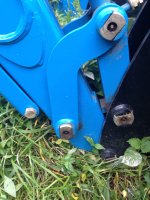SPYDERLK
Super Star Member
- Joined
- Feb 28, 2006
- Messages
- 10,160
- Location
- VA
- Tractor
- JD2010, Kubota3450,2550, Mahindra 7520 w FEL w Skid Steer QC w/Tilt Tatch, & BH, BX1500
Theyre not stretching. Its a compression thing that happens when resisting uncurl. When they buckle there is a sudden uncurling. That would drop something. It would by definition be a heavy load and the buckle could be catalyzed be a jerk stop on lowering ... or a lift with a critical amt of load ... or a lift too high with load -- because the compression leverage increases with the degree of uncurl. ... Imagine using pallet forks. Keeping level as you raise.This link (in the fuse theory) will either compress or stretch, I don't think it drops anything.
If in fact it is (in part) a fuse, highest forces are when the bucket is curled all the way down, precisely the condition where forces multiply, and may be a need to protect the bucket curl cylinders or other mounts. I suspect it is shaped this way to give the bucket more curl while protecting the components in this extended curl position. Seems strange that LS wouldn't state this (again, following the 'fuse' theory) so people know whats going on rather than guessing about their quality.
Ryan what was the bucket angle when you pushed on this cedar tree?
larry
